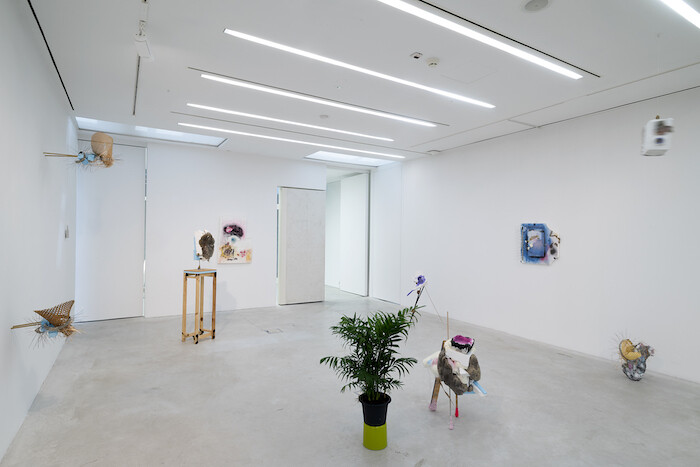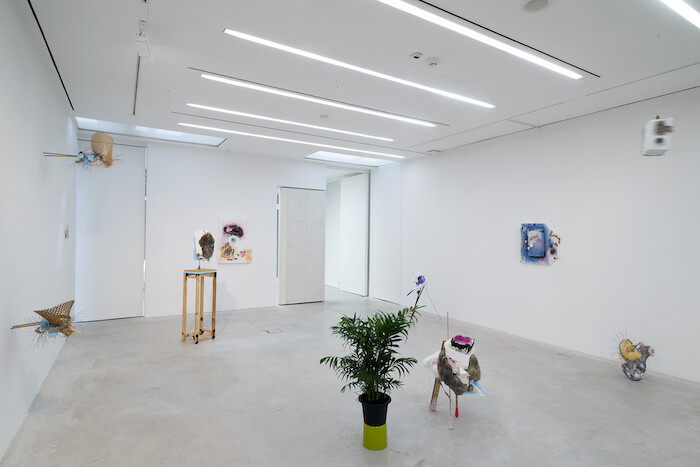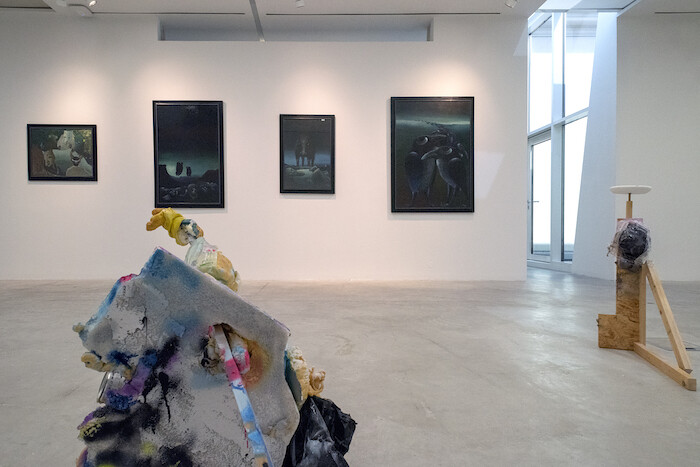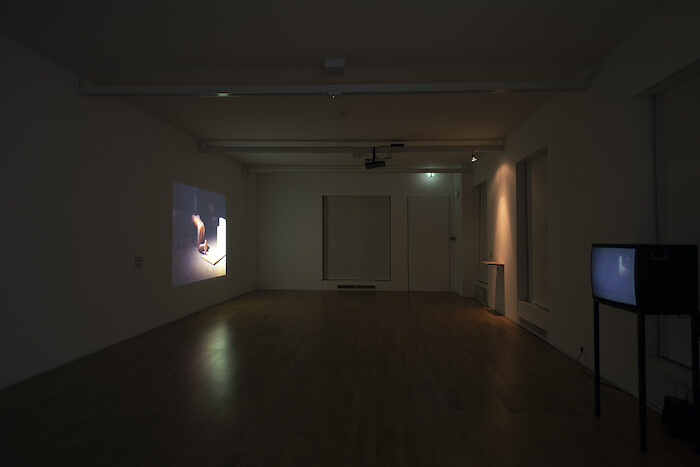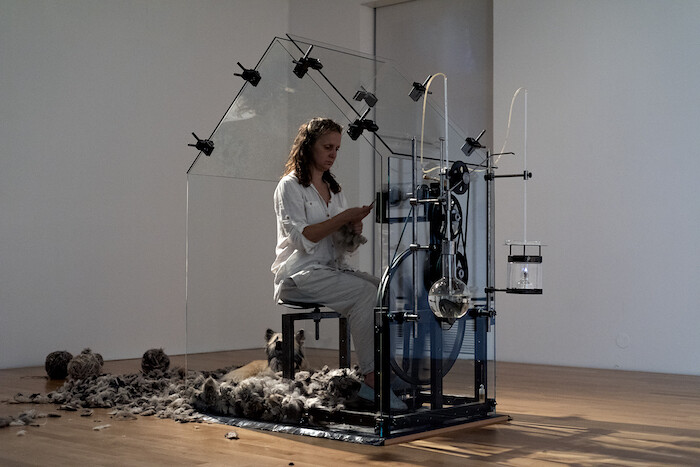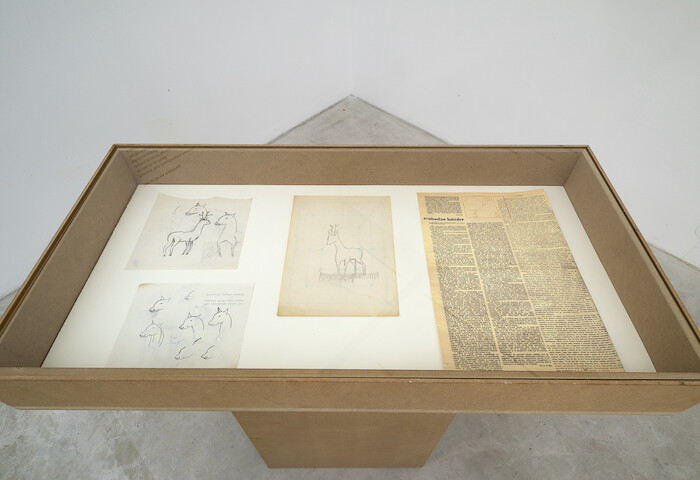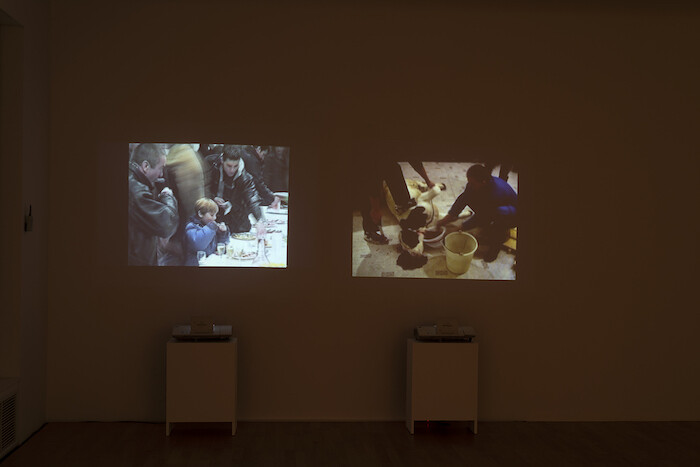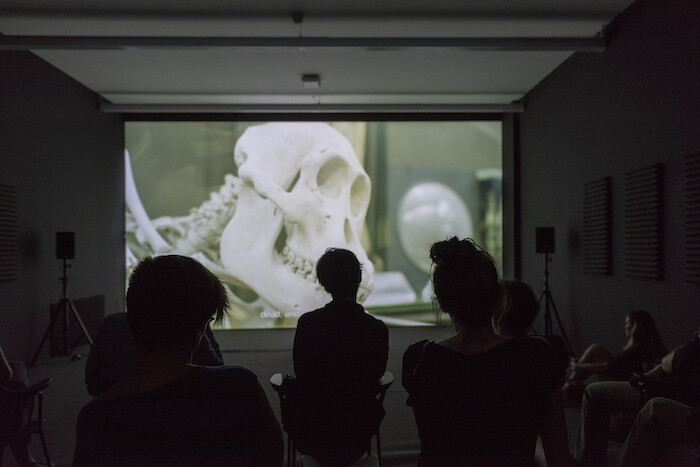“[A]re humans able to resist together with plants and animals?”1 With this question, Zdenka Badovinac and Bojana Piškur invite viewers to consider the possibility that all living things can coexist—and co-resist. Most animals are so dependent on human actions and choices for their survival: they likely do not ponder ways to revolt against capitalism. Unless, like the animals in George Orwell’s Animal Farm (1945), they already have an anthem, a flag, and the Seven Commandments necessary to rise against humans. Indeed, we might imagine that animals have already elected a new species to act as leaders, and decided what position humans will occupy. But why would humans—who use animals for food, religious rituals, transport, and entertainment—be granted any position in the animals’ new world?
Several works in “Heavenly Beings” explore potential synergies between humans and animals. Maja Smrekar’s Hybrid Family (2016), for example, is a series of black-and-white photographs documenting a three-month performance during which the artist trained her body to produce breast milk, which she fed to a puppy she was living with. Correlated in content and form is Opus et domus (2018), in which Smrekar spins yarn from dog and human hair on a spinning-wheel. Broaching gender, family values, and the position of women as mothers, both projects reflect on the processes of, and differences produced by, what Giorgio Agamben has called the “anthropological machine.”2
Photographic documentation of Oleg Kulik’s work presents another take on the connection between the human and animal worlds. In Dog House—a notorious 1996 performance at Stockholm’s Färgfabriken gallery—Kulik crawled around on his hands and knees, with a chain around his neck, behaving like a dog. When a visitor ignored the warning not to overstep the boundaries of the “dog’s” territory, Kulik bit them—and was subsequently arrested. The performance caused a scandal, prompting the artist to explain his motives and the background in an open letter.3
Some of the works depict animal slaughter, a subject that can provoke aversion and disgust, despite the fact that innumerable animals are slaughtered daily to feed humans’ carnivorous tastes. This hypocritical attitude was at the center of Where is the Line?, Franc Prug’s 1998 performance at the Škuc Gallery, presented as video documentation. In the back room of the gallery, the artist butchered a calf with the assistance of a professional butcher, while a vast majority of the visitors at the opening feasted on a mostly meat-based buffet in the adjoining room. For the opening night of “Heavenly Bodies,” Sven Stilinović remade his 1993 performance Geometry of Bloodthirstiness: he brought a whole roast lamb to the opening, cut it up in front of the audience, and offered it to them with bread and wine. They ate it all.
Tanja Lažetić’s Berlin Zoo, 1965–2006 (2018) juxtaposes two photographs of a lion in the Berlin Zoo, one taken by her grandmother in 1965 and the other taken by the artist in 2006. Berlin saw dramatic social, political, and economic change in the intervening years, but nothing changed for the lions—not even their cage. Poet Jure Detela thought about zoos as prisons for animals in the 1970s. In 1975, he broke into the Ljubljana Zoo to set forest animals free, true to his ideas on animal rights and ways to transcend established human/animal relationships.
A more lighthearted note is struck by Vladimir Leben’s A Dog’s Life (2013), produced in collaboration with embroidery studio Ercigoj Art: a triptych of embroidered paintings portraying the stray dogs that ride Moscow’s subway every day in search of food. Siniša Labrović parodies human-animal relationships to the point of absurdity in Flock.org (2005), a reality show featuring sheep. By voting for their favorites, spectators assumed responsibility for deciding between life and death: the eliminated sheep would be butchered unless saved by a spectator willing to live with it in their home for 24 hours. The winning sheep got a contract ensuring it a lifetime of care, while the spectators got plenty of opportunities to save lives. In his video Immortality and Resurrection for All! (2017), Anton Vidokle (the editor of e-flux journal), explores the influence of the utopian tenets of Cosmism—the now largely forgotten Russian philosophy combining Marxism, Eastern and Enlightenment thought, and Orthodox Christianity—on life in the twentieth century and its relevance to the present. The final chapter of a trilogy of videos—comprising This Is Cosmos (2014) and The Communist Revolution Was Caused By The Sun (2015)—it meditates on the museum as the site of resurrection of all life. One cannot help but wonder if animals, like humans, want life after death.
Zdenka Badovinac and Bojana Piškur, exhibition notes, http://www.mg-lj.si/en/exhibitions/2369/heavenly-beings-neither-human-nor-animal/.
Giorgio Agamben, The Open: Man and Animal, (Palo Alto, CA: Stanford University Press, 2002).
Oleg Kulik, “Why Have I Bitten a Man? An Open Letter of Oleg Kulik,” in Interpol: The Art Exhibition Which Divided East and West, eds. Eda Čufer and Viktor Misiano (Ljubljana and Moscow: IRWIN and Moscow Art Magazine, 2000), 37–38.
